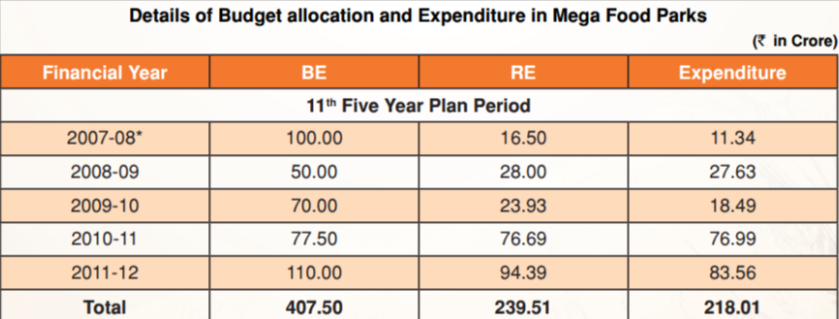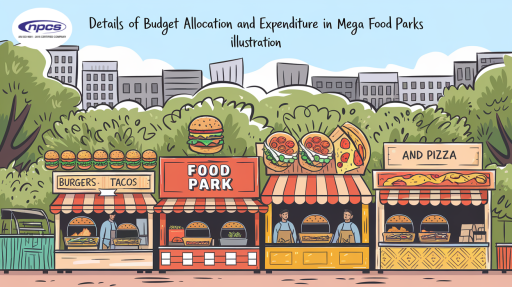India requires Mega Food Parks (MFPs) as a fundamental component to strengthen its food processing infrastructure. Indian government allocates substantial funds to these parks because they seek improved food safety standards and higher export potential and a booming rural economy. This article conducts a detailed exploration of the budgetary and expenditure activities within Mega Food Parks along with their effects on India’s food processing industry.

What Are Mega Food Parks?
The Indian food processing sector receives its supply needs through these large-scale facilities known as Food Parks. Food processing industries located in these parks benefit from facilities that organize the movement of goods from farms to markets. Common facilities at these parks include cold storage along with warehousing and packaging services and they pursue an inductroin of Indian food processing capabilities. These parks enable big-scale operations which simultaneously combat food destruction and produce new jobs while expanding agricultural economic development in India.
The analysis of government funds allocated to MFPs and their distribution
The government uses budget allocation for Mega Food Parks as the main element of its food processing industry development strategy. The governmental allocation of funds for Mega Food Parks development becomes substantial on an annual basis. The presented data in the table demonstrates how funds from the budget get distributed and disbursed.
Budget Allocations Over the Years
An extensive amount of government financial support has been allocated for the infrastructure construction of Mega Food Parks spanning different stages. The budgetary investment for Mega Food Parks during the period from 2007 to 2012 reached ₹407.50 crores. Between 2007 and 2012 the program received ₹218.01 crores in expenditure from the budgeted amount of ₹218.01 crores.
During the 11th Five Year Plan’s four financial years between 2007-08 to 2010-11 government budgets titled between ₹50 crores and ₹100 crores per year.
The 12th Five Year Plan Period
During the 2012-2017 period of the 12th Five Year Plan the government allocated increased funds for Mega Food Park development. From 2012-13 through subsequent years BE increased from ₹86 crores to ₹664.30 crores. The Government demonstrated increased dedication to Mega Food Parks when Budgetary Expenditure (BE) reached ₹664.30 crores in 2016-17.
The table indicates significant budget growth because the 12th plan period consumed ₹783.10 crores. The Mega Food Parks program receives greater budgetary support because its pace of implementation and its national development role continues to intensify.
Expenditure Distribution
The total financial investment from 2007 to 2024 is predicted to reach ₹1,790.65 crores. The financial plan of 2017 onwards emphasizes sector requirements in the food processing industry by enhancing infrastructure and technological developments across both the 13th and 14th plans.
Multiple types of costs emerge from the expenditure breakdown – it applies to land purchase together with facility development along with technological installations and logistics system upgrades. The made investments guide the efficient operation of Food Parks to offer essential resources for food processing businesses to succeed.
The Growing Role of Mega Food Parks in Economic Development
Budgetary support for Mega parks keeps increasing because of rising understanding of their role in strengthening the national economy. Mega Food Parks serve as crucial facilities for agricultural produce transformation to create products which can be marketed domestically and globally.
Infrastructure investments in food processing which government implements will help diminish food waste while lengthening shelf-lives together with strengthening India’s market position in global food export markets. All groups within India’s agricultural community will gain from this initiative that strengthens both agricultural output and nationwide food security and nutritional improvement.
Why Should Businesses Focus on Mega Food Parks?
Organizations involved in food processing can achieve major business advantages through the programs established at Mega Food Parks. The Mega Food Parks Budget Allocation provides government support to business infrastructure which combines modern technologies with financial resources for business expansion. Now that food processing businesses receive more potential for expansion they can achieve increased growth opportunities.
Mega Food Parks represent a fundamental initiative that generates business prospects and establishes sustainable food distribution systems throughout India. Businesses that receive enhanced infrastructure technologies maintain better operational efficiency while lowering their resource waste while gaining access to previously unavailable markets both domestically and abroad.
Opportunities for Startups and Entrepreneurs
The government’s enhanced interest in Mega Food Parks provides startup food processors with an outstanding business prospect. The created facility employs modern setups which enable small to medium enterprises to accelerate their growth while they obtain resources and facilities required to fight established corporate competitors.
Startup enterprises can harness government funding through participation in highly equipped food processing systems located across India. Venturing into advanced technology combined with modern logistical infrastructure coupled with good storage capabilities enables startups to reduce expenses and create superior products while extending their market territory.
Mega Food Park: Encouraging Food Projects in India.
How Can Businesses Leverage Government Initiatives?
The government makes noteworthy efforts to support Mega Food Parks yet business effectiveness depends on their capability to utilize governmental resources. Companies should engage with the program to benefit from financial support and tax motivation alongside subsidy benefits.
Food processing companies should integrate with worldwide market trends by investing into their production and sustainability efforts. By developing a strategic alignment businesses will achieve both domestic success in India and international market entry.
Conclusion
The government of India places high importance on Food Parks Budget Allocation since it serves as a key component in improving food processing infrastructure nationwide. These parks play a crucial role in industrial transformation because the government maintains support through budget increases year by year. The implementation of Food Parks enables companies and startups to act as key agents for advancing the nation’s agricultural economic growth.
Consult NIIR for professional guidance related to these business opportunities together with consulting services which can boost your business growth. The government initiatives require specific consulting guidance which our team delivers to maximize their benefits. Our organization exists to support both newly established startups entering the food processing sector and existing businesses attempting expansion.
Businesses which follow these procedures together with available resources will actively contribute to India’s ongoing food processing transformation.







